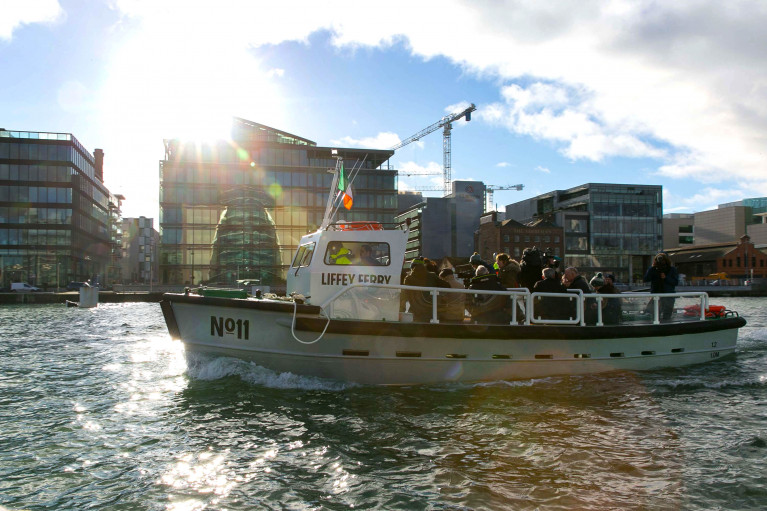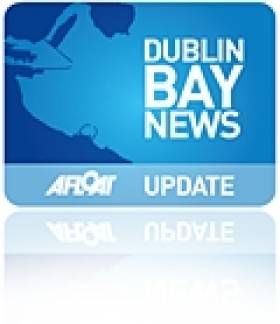Displaying items by tag: Dublin 'Docklands'
A Polish flagged tallship which arrived into Dublin Port yesterday evening had also its own Sea Shanty choir on board, writes Jehan Ashmore.
The sail training ship, STS Kapitan Borchardt of the Polish Scouting Association once a year, brings the floating choir members of the Zawisza Czarny on a voyages to perform concerts in ports and to celebrate their home port of Gdynia.
The vessel built in 1918 is the oldest sailing ship currently flying the Polish Flag which last month took part in the Tall Ship Races with a call to the UK host port of Hartlepool, an English North Sea port.
Kapitan Borchardt has since also visited this week Belfast, Ardrossan on the Forth of Clyde and off the Scottish mainland, Port Ellen on Islay.
On arrival to Dublin Port, the tallship took a berth on Sir John Rogerson’s Quay where it will remains in the port for its second overnight in the capital.
The male choir of Zawisca Czarby is made up of crew members of the Kapitan Borchardt and ‘singing sailors’ and is believed to be the largest, regularly performing sea shanty choir in the world.
On such ports of call, the Zawisza Czarny choir welcomes the public to visit the quay and witness the amazing Sea Shanty Choir, as they perform from the tall ship’s deck and keep this maritime tradition and heritage alive.
Singers range between 18 and 70 and total 50 in a choir that is Poland’s only sea shanty choir and is recognized as one of the world’s finest in its category.
Tomorrow, in the early hours, marks another leg of the tallship’s crew choir, as it departs on a 7 night passage calling to Plymouth, Cornwall and ending in Cherbourg, France.
It's back the Old Liffey Ferry service in Dublin's 'Docklands' has returned following easing of Covid-19 restrictions but running in a more subdued environment of the financial and cultural quarter since the outbreak broke, writes Jehan Ashmore.
Operators of the historic river-crossing granted a Royal Charter of 1665 but with origins stretching further back to the 1400's, has in the present day seen ferry No.11 operating to a strict social distancing measure regime. In addition capacity has been considerably reduced from 18 passengers down to just 9 onboard any given crossing. This is to ensue passenger and crew safety during the brief crossing along the capital's under-used water thoroughfare compared to other European capitals, notably in Scandinavia.
The No.11 ferry was due to resume the seasonal service in March but is now available running to a routine Mondays to Fridays schedule. This involves serving three pontoon-based stops lining the Liffey quays. They are on the North Wall next to static-berthed Cill Airne and opposite on the south bank at Sir John Rogerson's Quay before returning across the Liffey to The Point Depot (3Arena) near the East-Link (Tom Clarke) Bridge.
Operating time are as follows:
Mornings: 8am - 10am
Lunchtime: 12pm - 2pm
Evenings: 4pm - 6:30pm
Last year the restored Liffey No.11, an original ferry from the service that closed in 1984 following the opening of the East-Link toll lift-bridge, was re-launched by The Irish Nautical Trust along with the Dublin Port Company and Dublin City Council.
The venture brings back and highlights the proud tradition of the Liffey ferry where dockers commuted across the river before the service ceased due to the new East-Link bridge which remains a vital part of the port's infrastructure and also for commuters.
The bridge was never officially named until recent years as the Tom Clarke Bridge with its lift-bridge section can be raised to permit vessels to reach the capital's older former port quays. These days there is no commercial shipping traffic since regular 'stout' tankers The Lady Patricia and Miranda Guinness ceased trading to Merseyside in the early 1990's. The only callers now are Irish Naval Service patrol ships, visiting naval vessels, motoryachts and tallships notably during festivals that have become infrequent in the last decade.
Currently the only 'Liffey' based activity, albeit domestic is the summer excursion operator, Dublin Bay Cruises which in June resumed service following a delay of an original debut planned for St. Patrick's Day.
Likewise of No.11, DBC's 100 passenger capacity vessel has reduced capacity by 60% leaving 40 passengers to take excursions on a network of cruises involving calls to both harbours of Dun Laoghaire and Howth. In addition a cruise off Dalkey Island incorporating a visit into Killiney Bay.
Further south along the eastern seaboard, Arklow Marine Services carried out further work earlier this year as Afloat noted No.11 was hoisted out of the water, albeit not in Co. Wicklow port. The activity actually took place downriver of the 'Docklands' at the nearby Poolbeg Y&BC in Ringsend which forms part of the modern Dublin Port.
The works saw the installation of a new propellor manufactured by Jimmy Walsh Propellers & Marine Engineering based in Rosslare Harbour Co. Wexford. This is where AMS assisted and also carried out standard maintenance while the UK built ferry was out of the water.
Dublin Port Tugs Making Magic 'Rainbow' Happen
The spectacular effect of the life-size rainbow had never been achieved before in Ireland. Steve Green, the director of the advertisement used a 35mm film, with footage from HD cameras, including one mounted on the helicopter which hovered over the 'new' landmarks of the 'Docklands'.
The imaginative advertisement was created by Sweet Media, the production company chosen to produce the campaign, under the direction of the National Lottery's advertising agency, DDFH&B. The soundtrack for 'Making Magic Happen' is the appropriately titled 'Pocketful of Rainbows', sung by Elvis Presley. The version used is Take 16 from the 1960 recording sessions for the 'G.I. Blues' soundtrack.
As for the stars of the advert, the tugs are named after Irish figures, Shackleton, named in honour of Antartic explorer Sir Ernest Henry Shackleton and Beaufort, named after Navan-born, Sir Francis Beaufort, who created the world-renowned wind-scale measurement.
The 50-bollard ton tugs cost €6m each and were built at the Astilleros Zamakona Shipyard, Bilbao. In March the tugs officially entered service after a joint naming ceremony was held in Dublin Port.
To view the tugs in water-firing, making magic mode!... click the link here
Lightship To Lead A Rocky Life?
The Dublin 'Docklands' developer, Harry Crosbie is seeking permission from Dublin City Council to raise the 500-ton lightship, Kittiwake and place on the quayside opposite The 02 Theatre. Currently the lightship is berthed nearby the East-Link road toll bridge and acts as a notable floating feature to countless daily commuters.
In 2007, the Commissioners of Irish Lights (CIL) sold the 1959 built lightship to Crosbie. The 134-foot lightship had served in that role for many years around the Irish coast. In 1981, as part of an extensive modernisation programme, the Kittiwake and other lightships were converted into an automated light-float (ALF). The last station served by the ALF was at South Rock, Co. Down.
If the former lightship is given the green light, the vessel would act as a "welcoming point" for cruise tourists. Subject to planning permission, the lightship would undergo another re-conversion project to create an open-plan café bar for a period of five years.
The veteran vessel would also have its lighthouse light restored and would "beam" across the docklands and entertainment venue. The lightship would maintain its customary 'red' hull with Kittiwake written in neon on the side.
In order to attract this cruise business to the Kittiwake, Crosbie has asked the Dublin Port Company to relocate the main existing cruise-ship location closer to the O2 Theatre. The proposal has the support of Dublin City Council.
In the meantime the majority of cruise-ships dock at Alexandra Basin, in the heart of the port's industrial zone but the distance is quite far from there to the city centre.
On an annual the capital welcomes around 80,000 passengers during each season, generally between May to October. In 2011, the port expects 86 cruise-calls, potentially generating €35m to €55m to the economy.
The proposed for the new terminal is to be submitted to the EU this month, in the hope of financing support. Meanwhile the proposed site envisaged for the cruise terminal, is occupied by tugs based operated by Dublin Port Company.


























































